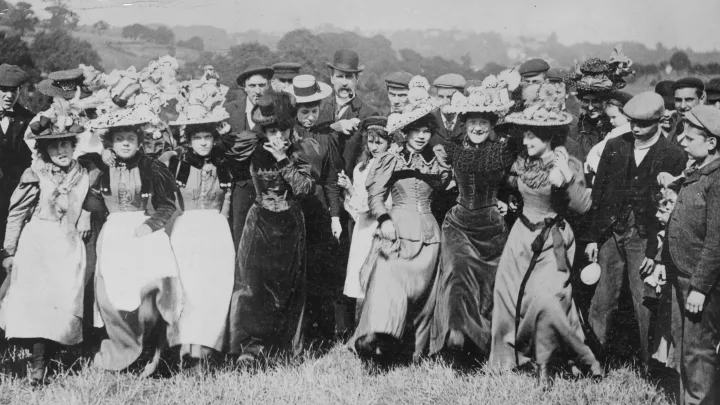Get ready for a captivating exploration of the history of Easter bonnets. From their humble beginnings to the elaborate creations we see today, we’ll uncover how these festive hats evolved and their significance in culture and tradition. Let’s take a closer look at the world of Easter bonnets, where fashion, religion, and societal trends intertwine.
History of Easter Bonnets
The origins of the Easter bonnet can be traced back centuries. It’s believed that the tradition emerged in medieval Europe, where Easter held immense religious significance. People would celebrate the holiday by donning their finest attire, symbolizing a fresh start and spiritual renewal. This practice of wearing new clothes for Easter could be where the concept of the Easter bonnet first took root.
During the late 19th century, Easter bonnets gained immense popularity in America, particularly in bustling New York City. The iconic Easter Parade, a grand procession down Fifth Avenue, became synonymous with extravagant bonnet displays. These parades, often featured in photographs and illustrations, showcased the creativity and artistry of bonnet makers.
The mid-20th century saw Easter bonnets transform into elaborate, eye-catching creations. Adorned with an abundance of flowers, feathers, ribbons, and other embellishments, they became a true spectacle of springtime festivity. These bonnets transcended mere headwear; they were wearable works of art, expressions of individuality, and a testament to the enduring appeal of tradition.
While the popularity of elaborate Easter bonnet displays might have waned in recent decades, the tradition endures, especially for children. From church services to family gatherings, these colorful creations continue to bring joy and a sense of springtime cheer. They serve as a reminder of the hope and new beginnings that Easter represents.
What Does the Easter Bonnet Symbolize?
Beyond their aesthetic appeal, Easter bonnets hold deep cultural and symbolic significance. They represent the essence of Easter – new beginnings, renewal, and the triumph of hope over adversity. Let’s delve into the multifaceted symbolism of these festive hats:
- Renewal and Rebirth: Easter bonnets, often adorned with flowers and springtime motifs, symbolize the renewal of life and the arrival of spring. This symbolism aligns with the Christian belief in the resurrection of Jesus Christ, representing a triumph over death and a promise of new beginnings.
- Fashion and Self-Expression: Throughout history, Easter bonnets have served as a canvas for creativity and self-expression, particularly for women. From simple, elegant designs to extravagant, attention-grabbing creations, bonnets allow individuals to showcase their unique style and personality.
- Community and Celebration: Easter bonnets, often worn during parades and community gatherings, foster a sense of togetherness and shared celebration. The sight of numerous colorful bonnets creates a vibrant and festive atmosphere, bringing people together to commemorate the Easter holiday.
The beauty of the Easter bonnet lies in its ability to hold different meanings for different people. Some may view it as a tribute to their faith, while others may focus on the celebration of spring and the beauty of new beginnings. The interpretation, ultimately, is deeply personal.
Where Do Easter Bonnets Originate?
The precise origins of the Easter bonnet may be shrouded in some mystery, but historians suggest they likely emerged from a confluence of cultural and religious practices in 16th-century Europe. During this era, Easter was a time for new beginnings, and people would mark the occasion by wearing their finest attire.
This tradition of wearing new clothes for Easter, a symbolic shedding of the old and embracing of the new, likely played a role in the development of the Easter bonnet. Early bonnets were probably more functional than fashionable, serving as simple head coverings that evolved into more elaborate creations.
As the tradition spread beyond Europe, it’s plausible that it underwent transformations, incorporating regional customs and interpretations. The Easter bonnet, as we know it today, likely reflects centuries of cultural fusion and adaptation.
Why Do We Decorate Easter Bonnets?
The tradition of decorating Easter bonnets adds another layer of meaning to these festive hats. Adornments, ranging from simple flowers to elaborate Easter-themed creations, hold symbolic significance and contribute to the joyous atmosphere of the holiday.
- Flowers: Flowers, often associated with spring and new life, are a popular choice for Easter bonnet decorations. They represent rebirth, growth, and the beauty of the natural world, aligning with the themes of Easter.
- Easter Symbols: Bunnies, chicks, and eggs are other common motifs found on Easter bonnets. These playful symbols represent fertility, new life, and the joy of the Easter season.
- Ribbons and Embellishments: Ribbons, lace, and other embellishments add a touch of elegance and festivity to Easter bonnets. These decorative elements enhance the visual appeal and contribute to the overall celebratory mood.
The act of decorating Easter bonnets also provides a creative outlet, allowing individuals to express their artistic flair and personalize their creations. For many, it’s a fun and engaging activity that adds to the enjoyment of the Easter holiday.
What Is the History of the Bonnet Hat?
While we’ve been focusing on Easter bonnets, it’s worth exploring the broader history of the bonnet hat itself. Bonnets, as a type of headwear, have a long and fascinating past, evolving from practical garments to fashion statements.
Early bonnets, dating back centuries, were often simple, functional hats worn by women for warmth and protection from the elements. Over time, bonnets became more stylized, incorporating different materials, shapes, and decorations.
During the 19th century, bonnets reached the peak of their popularity as a fashionable accessory for women. They were often made from luxurious fabrics, adorned with lace, ribbons, and feathers, and served as a symbol of social status and style.
While the popularity of bonnets declined in the early 20th century, they never entirely disappeared. They experienced a resurgence in the mid-20th century, with designers reimagining them as chic and stylish accessories. Today, while not as ubiquitous as they once were, bonnets continue to hold a place in fashion, often seen as vintage-inspired or statement pieces.
What Is the Cultural Significance of the Bonnet?
The bonnet, as a type of headwear, holds diverse cultural significance, varying across time periods, regions, and social groups. Its meaning extends beyond mere fashion, reflecting social norms, religious beliefs, and personal expression.
- Modesty and Tradition: In many cultures, bonnets have been associated with modesty and tradition, particularly for women. Covering one’s head, whether for religious reasons or as a social custom, often holds symbolic meaning, signifying respect, humility, or adherence to tradition.
- Social Status and Identity: Bonnets, particularly those made from luxurious materials or featuring elaborate designs, have historically served as indicators of social status and wealth. The style and quality of a bonnet could convey a message about the wearer’s social standing and taste.
- Practicality and Protection: Beyond their symbolic and social significance, bonnets have also served practical purposes. They provide protection from the sun, wind, and cold, making them essential garments for outdoor work or travel.
The cultural significance of the bonnet continues to evolve, with contemporary interpretations often blending tradition with modern sensibilities. From vintage-inspired designs to contemporary reinterpretations, bonnets remain a fascinating reflection of culture, identity, and self-expression.
What Is the Spiritual Meaning of the Bonnet?
The spiritual meaning of the bonnet varies depending on cultural and religious contexts. In many Christian traditions, covering one’s head, particularly for women, holds spiritual significance, representing humility, respect, and submission to God’s authority.
While the Bible does not specifically mention bonnets, it does address head coverings in the context of worship and prayer. The apostle Paul, in his letters to the Corinthians, discusses the practice of women covering their heads during prayer and prophecy, suggesting it was a sign of respect and recognition of God’s order.
It’s important to note that interpretations of these biblical passages vary among Christian denominations. Some view head coverings as a binding requirement for women, while others see them as a cultural custom of the time that no longer applies.
Regardless of specific interpretations, the act of covering one’s head, particularly in a religious context, often holds deep spiritual significance, representing reverence, humility, and a connection to the divine.
What Does Bonnet Mean in the Bible?
As mentioned earlier, the word “bonnet” itself does not appear in the Bible. However, the concept of head coverings, particularly for women in the context of worship and prayer, is discussed in the New Testament.
The most well-known passage regarding head coverings is found in 1 Corinthians 11. In this letter, the apostle Paul addresses the practice of women covering their heads during prayer and prophecy. While interpretations of this passage vary, it suggests that head coverings were a customary practice in the early church, possibly signifying a woman’s submission to God’s authority and the order of creation.
Another passage, found in 1 Timothy 2:9-10, encourages women to “adorn themselves in modest apparel, with shamefacedness and sobriety,” which is often interpreted to include head coverings. These passages highlight the cultural and religious significance of head coverings in the early church, though their specific application and relevance to contemporary practices remain a subject of debate among Christians.
What Does It Mean to Wear a Bonnet?
The meaning attributed to wearing a bonnet is multifaceted, influenced by historical context, cultural norms, and personal interpretations. Throughout history, bonnets have been worn for various reasons, reflecting practical needs, social customs, religious beliefs, and personal style.
- Practicality: Historically, bonnets served as practical garments, providing warmth, shade, and protection from the elements. They were worn by women of all social classes, particularly those engaged in outdoor work or travel.
- Modesty and Tradition: In many cultures, bonnets, especially those worn by women, have been associated with modesty, humility, and adherence to tradition. Covering one’s head, particularly in religious contexts, often carries symbolic meaning.
- Fashion and Self-Expression: As bonnets evolved from purely practical garments to fashionable accessories, they became a way for women to express their personal style, creativity, and social standing.
- Cultural Identity: In some cultures, specific types of bonnets are associated with particular regions, religions, or social groups. Wearing these bonnets can signify a sense of belonging and cultural identity.
The interpretation of wearing a bonnet ultimately depends on the wearer and the context in which it is worn. It can be a statement of faith, a nod to tradition, a practical accessory, or a fashion choice that reflects the wearer’s individuality.
What Is the Easter Egg Supposed to Symbolize?
The Easter egg, a ubiquitous symbol of the Easter holiday, holds rich layers of meaning, blending ancient pagan traditions with Christian beliefs. Its symbolism revolves around the concepts of new life, rebirth, and the potential for growth and transformation.
- Pagan Origins: Long before Easter, eggs held symbolic significance in ancient pagan celebrations of spring and fertility. They represented the earth’s reawakening after winter, the promise of new life, and the cyclical nature of the seasons.
- Christian Symbolism: With the rise of Christianity, the egg took on new meaning, becoming associated with the resurrection of Jesus Christ. Just as a chick hatches from an egg, symbolizing new life emerging from a seemingly lifeless shell, Christ’s resurrection represents the triumph of life over death and the promise of eternal life.
- Modern Interpretations: Today, Easter eggs continue to symbolize hope, renewal, and the joy of the Easter season. The tradition of decorating eggs, whether with vibrant dyes, intricate patterns, or playful designs, adds a festive touch to the celebration and provides a creative outlet for people of all ages.
The enduring appeal of the Easter egg lies in its ability to transcend cultural and religious boundaries, resonating with people from all walks of life. Its message of hope, renewal, and the promise of new beginnings continues to hold deep significance, even for those who may not celebrate Easter in a religious context.
What Does the Amish Bonnet Mean?
The Amish bonnet, a distinctive garment worn by Amish women, holds profound cultural and religious significance within their community. It represents their commitment to modesty, humility, and adherence to traditional values.
- Modesty and Submission: Amish women wear bonnets as a visible symbol of their religious beliefs, particularly their commitment to modesty and submission to God’s authority. The bonnet, covering the head and hair, represents their desire to deflect attention from outward appearance and focus on inner beauty and spiritual growth.
- Marital Status and Community Identity: The color and style of an Amish bonnet can indicate a woman’s marital status and community affiliation. For example, married women typically wear white bonnets, while unmarried women wear black bonnets. These visual cues help to maintain social order and reinforce community bonds.
- Practicality and Tradition: Amish bonnets, often made from simple, durable materials, also serve practical purposes. They provide protection from the sun, wind, and rain, essential for women engaged in outdoor work. The bonnet’s design remains largely unchanged, reflecting the Amish commitment to tradition and simplicity.
- Craftsmanship and Identity: Amish women take great pride in crafting their own bonnets, often by hand. This meticulous process reflects their value of craftsmanship, attention to detail, and self-sufficiency. The bonnet, therefore, becomes more than just a garment; it’s an expression of their cultural identity and way of life.
The Amish bonnet, with its understated elegance and deep-rooted symbolism, offers a glimpse into the values and beliefs of this unique and resilient community. It serves as a tangible reminder of their commitment to faith, family, and a way of life that prizes simplicity, humility, and a harmonious relationship with God and nature.
Want to Explore More?
Delve deeper into the rich tapestry of history and craftsmanship:
- Discover the captivating history of crochet and how this ancient art form evolved over centuries.
- Immerse yourself in the rich history of Daufuskie Island, where time seems to stand still and the past whispers through its charming streets.
- Uncover the hidden layers of history of Edisto Island, SC and embark on a journey that unveils the stories of its vibrant past.
- SYBAU See You Baby Meaning: Gen Z Slang Evolves - July 1, 2025
- Unlock Your Inner Youth: Lifestyle Secrets for a Vibrant Life - July 1, 2025
- Decode SYBAU Meaning: Gen Z Slang Explained - July 1, 2025






